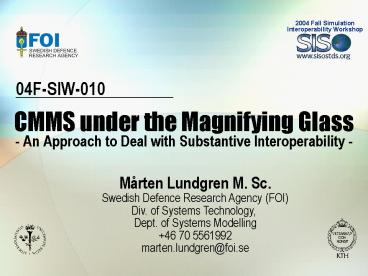CMMS under the Magnifying Glass - PowerPoint PPT Presentation
1 / 13
Title:
CMMS under the Magnifying Glass
Description:
2004 Fall Simulation Interoperability Workshop. CMMS under ... marten.lundgren_at_foi.se. 09/22/2004. 04F-SIW-010. Page 2. Who we are. Swedish Ministry of Defence ... – PowerPoint PPT presentation
Number of Views:308
Avg rating:3.0/5.0
Title: CMMS under the Magnifying Glass
1
CMMS under the Magnifying Glass
- - An Approach to Deal with Substantive
Interoperability -
Mårten Lundgren M. Sc. Swedish Defence Research
Agency (FOI) Div. of Systems Technology, Dept.
of Systems Modelling 46 70 5561992 marten.lundgre
n_at_foi.se
2
Who we are
- Swedish Ministry of Defence
- Swedish Defence Research Agency (FOI)
- Systems Technology Division
- Department of Systems Modelling
- Methods and technologies for complex modeling and
simulation.
3
Progress at FOI
- 2001/2002 Usefulness of concept
- 2003 Further investigation
- KA / KE
- Tool support
- Syntax and semantics
- Limitations in CMMS KA / KE
- Ideas on how to solve them
4
CMMS at a glance
Real world
Develop Focused Context
Knowledge Engineering
Gather Information
Formalize Data
Construct CMMS
Knowledge Acquisition
5
Perceived limitations of CMMS
- Process dependent
- Poor methodology support
- Poor modeling abilities
6
Limitation 1 Process dependency
- Too specific ? not reusable.
- Too complex ? not understandable
1 aim
3 fire
2 breathe
Activity
1 aim
Choice
3 fire
2 breathe
7
Solution 1 Activity centric models
process chain of events
- Increased reusability
- Decreased complexity
8
Limitation 2 Poor methodology
- No basic approach to knowledge
- Too general
- Only KE focused.
- Misses many critical questions
- How to delimit scope?
- How to identify SMEs?
- How to automate knowledge refinement?
- How to solve syntax and semantics issues?
- Etc....
9
Solution 2 Activity based KA and KE
- Develop KA to support KE
- Activity centric modeling proved helpful
- Conform to common standards
- Interoperability benefits
10
Limitation 3 Poor modeling abilities
specific
generic
complex
11
Solution 3 Meta-layers
- Meta-layers classify components and add semantics
- Meta-meta layers enable even more semantics
- Further mapping to MOF enables automation of
mapping - between notations or even code generation.
3. Reader makes assumptions
2. Knowledge engineer formalizes information
1. Information recieved from SMEs view
12
Summary Limitations
- Process dependent models are poor analogies of
reality which causes problems in complexity and
modularity. - Coarse and incomprehensive CMMS methodology gives
little or no support to important issues. - Flat models cannot represent knowledge
efficiently, or automate mapping of views. - ? complex and difficult to reutilize knowledge
models that limit substantive interoperability.
13
Summary Solutions
- Use a basic approach like activity centric
concepts. - Develop a detailed methodology based on this
approach. - Use a standardized meta-modeling framework that
enables abstraction extension - Modularity
- Automation
- Interoperability































